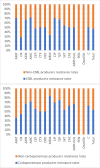Bacterial isolates and antibiotic resistance in critically ill sepsis patients at a tertiary hospital in Ethiopia
- PMID: 40830847
- PMCID: PMC12366403
- DOI: 10.1186/s12879-025-11474-5
Bacterial isolates and antibiotic resistance in critically ill sepsis patients at a tertiary hospital in Ethiopia
Abstract
Background: Sepsis is a pressing global public health issue, particularly among patients admitted to intensive care unit (ICU), and it is linked to a high incidence of morbidity and mortality. Current understanding of bacterial profiles, antibiotic resistance patterns, and the magnitude of Extended-Spectrum Beta-Lactamase (ESBL) and Carbapenemase (CP) producing isolates in critically ill patients is vital for implementing strong management approaches tailored to combat antibiotic resistance and improve patient outcomes.
Methods: A prospective cross-sectional study was carried out involving 149 patients admitted to ICU with a presumptive diagnosis of sepsis at Jimma University Medical Center (JUMC) from October 2023 to October 2024. A structured questionnaire was administered to collect baseline demographic and clinical characteristics of the patients. Blood samples were aseptically collected and analyzed using standard microbiological technique to identify bacterial isolates. The Kirby-Bauer disc diffusion method was employed to conduct the antimicrobial susceptibility test. The MASTDISCS® Combi AmpC and ESBL detection discs D68 C, and Combi Carba plus disc system D73C were used to examine ESBL and CP production, respectively.
Results: Bacterial pathogens were isolated from 33 patients, representing an isolation rate of 22.1% (95% CI: 16.2-29.6%). Gram-negative bacteria (GNB) accounted for the majority of the isolates, 25/33 (75.8%), with Escherichia coli, 6/25 (24%) being the predominant species. Administering antibiotics before sample collection was associated with a lower likelihood of culture positivity (AOR: 0.05, 95% CI: 0.01-0.38; p = 0.004). In contrast, prolonged stay in the ICU was positively associated with culture positivity (AOR: 1.13, 95% CI:1.02-1.24; p = 0.02). Gram-negative bacteria exhibited a particularly high resistance to third- and fourth-generation cephalosporins, ranging from 66.7 to 80%. ESBL and CP producers accounted for 11/25 (44%) and 12/25(48%) of GNB, respectively. Additionally, 80% of Staphylococcus aureus isolates were methicillin resistant. Overall, about a third of all isolates, 11/33 (33.3%) were multidrug resistant strains.
Conclusions: The study shows a significant burden of MDR pathogens among critically ill sepsis patients, characterized by high prevalence of ESBL, CP, and MRSA. These findings underscore the urgent need to strengthen antibiotic stewardship and infection prevention strategies to curb resistance in ICU environments.
Clinical trial number: Not applicable.
Keywords: Antimicrobial resistance; Bacterial isolates; Critically ill; Ethiopia; Sepsis.
© 2025. The Author(s).
Conflict of interest statement
Declarations. Ethics approval and consent to participate: Ethical approval for this study was granted by the Institutional Review Board (IRB) of Jimma University Institute of Health (reference number: JUIH/IRB/309/23). Prior to the commencement of the study, written informed consent from adults aged 18 and above, and assent from children aged 12 and above was obtained. Informed consent was obtained from legal guardians and caregivers for the minors and impaired consciousness participants. Participants were thoroughly briefed on the study’s objectives and procedures before the study. Involvement in the study was entirely voluntary. All collected information was kept confidential and used exclusively for this research. Any positive results were immediately communicated to the attending physician to ensure proper and timely treatment for the patients. Consent for publication: Not applicable. Competing interests: The authors declare no competing interests.
Figures




Similar articles
-
Magnitude of multidrug-resistant and extended-spectrum β-lactamase-producing gram-negative bacteria from tracheal aspirates of intensive care unit patients in Ethiopia.PLoS One. 2025 Jun 24;20(6):e0324199. doi: 10.1371/journal.pone.0324199. eCollection 2025. PLoS One. 2025. PMID: 40554487 Free PMC article.
-
Bacteriological profile and antimicrobial resistance in sepsis cases in intensive care units in Lubumbashi: challenges and perspectives.Ann Clin Microbiol Antimicrob. 2025 Jul 16;24(1):42. doi: 10.1186/s12941-025-00811-w. Ann Clin Microbiol Antimicrob. 2025. PMID: 40671057 Free PMC article.
-
Fosfomycin resistance in extended-spectrum beta-lactamase producing Escherichia coli isolated from urinary tract-infected patients in a tertiary care hospital.J Med Microbiol. 2025 Jul;74(7):002039. doi: 10.1099/jmm.0.002039. J Med Microbiol. 2025. PMID: 40658603 Free PMC article.
-
Bacterial profile and antimicrobial resistance patterns among pediatrics patients with suspected bloodstream infections in Ethiopia: a systematic review and meta-analysis.BMC Infect Dis. 2025 Aug 9;25(1):1008. doi: 10.1186/s12879-025-11427-y. BMC Infect Dis. 2025. PMID: 40783681 Free PMC article.
-
Automated monitoring compared to standard care for the early detection of sepsis in critically ill patients.Cochrane Database Syst Rev. 2018 Jun 25;6(6):CD012404. doi: 10.1002/14651858.CD012404.pub2. Cochrane Database Syst Rev. 2018. PMID: 29938790 Free PMC article.
References
-
- Singer M, Deutschman CS, Seymour CW, et al. The third international consensus definitions for sepsis and septic shock (Sepsis-3). Acta Med Okayama. 2012;66(4):299–305.
-
- WHO. Sepsis [Internet]. 2020 [cited 2021 Sep 17]. Available from: https://www.who.int/news-room/factsheets/detail/sepsis?__cf_chl_captcha_...
-
- Kiya GT, Mekonnen Z, Melaku T, Tegene E, Gudina EK, Cools P, et al. Prevalence and mortality rate of sepsis among adults admitted to hospitals in sub-Saharan Africa: a systematic review and meta-analysis. J Hosp Infect. 2024;144:1–13. - PubMed
MeSH terms
Substances
Grants and funding
- Mega Research Fund Scheme (2022-2025)/Research and Innovation Director (RID) office of Institute of Health, Jimma University
- Mega Research Fund Scheme (2022-2025)/Research and Innovation Director (RID) office of Institute of Health, Jimma University
- Mega Research Fund Scheme (2022-2025)/Research and Innovation Director (RID) office of Institute of Health, Jimma University
- Mega Research Fund Scheme (2022-2025)/Research and Innovation Director (RID) office of Institute of Health, Jimma University
- Mega Research Fund Scheme (2022-2025)/Research and Innovation Director (RID) office of Institute of Health, Jimma University
- Mega Research Fund Scheme (2022-2025)/Research and Innovation Director (RID) office of Institute of Health, Jimma University
- Mega Research Fund Scheme (2022-2025)/Research and Innovation Director (RID) office of Institute of Health, Jimma University
- Mega Research Fund Scheme (2022-2025)/Research and Innovation Director (RID) office of Institute of Health, Jimma University
LinkOut - more resources
Full Text Sources
Medical
Miscellaneous

